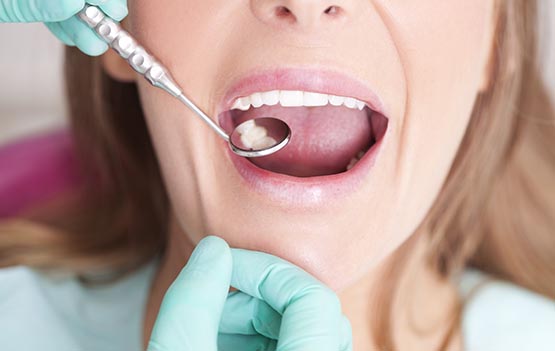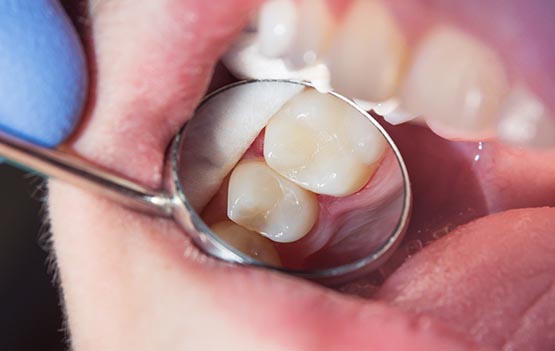

A tooth filling, also commonly referred to as dental fillings or fillings, is a special material your dentist in Gainesville, FL, uses to fill the hole made when they remove decay from or repair a broken tooth. There are several different types of materials that can be used in dental fillings. A filling can fall out for an array of reasons, whether it is due to new tooth decay developing in the tooth or around the filling or chewing too hard, or grinding your teeth in your sleep. In some patients, a lost filling can be more obvious than in others. If a filling falls out, you may feel the filling in your mouth or a space in your tooth, or you may not even notice you have a lost filling.
If your tooth filling fell out, you might also notice your tooth feels painful or is highly sensitized to extremely hot or very cold foods or drinks, or even the presence of cold air. If you have a loose filling, then the most important thing you can do is to contact Van Dyke General and Implant Dentistry to schedule a general dentistry appointment with your emergency dentist. We offer a range of emergency dental services, including treatment for broken teeth, toothaches, knocked-out teeth, teeth abscesses, and lost crowns. Contact our Gainesville dentist office today to learn more about our services and to schedule an appointment.
Dental fillings don’t last forever and in some cases, they can fall out. There are many different reasons why a filling may come loose and fillings can come loose at any time of day or night. If a filling fell out of a tooth, the first step you should take is to call Van Dyke General and Implant Dentistry to schedule an appointment for treatment.
While you wait to visit your dentist, it is important that you protect the tooth that lost the filling. Some of the most common reasons for a loose or lost filling include the following new tooth decay around the filling, chewing too hard on the tooth, biting into crunchy or hard foods, bruxism or grinding your teeth, dental trauma, and chemical reactions that loosen the filling.
Eating sticky foods can lead to gaps between your gum line and teeth. The gap allows for harmful bacteria to build up, which causes severe damage to the bone structure and supporting tissue.
If there is any saliva or moisture in your cavity when your Gainesville dentist is inserting your filling, it will not bond correctly. When the resin is unable to bond, your filling will fall out.
Bacteria and food may make their way underneath the filling. Because it is impossible for you to clean this area, this bacteria will decay your tooth and cause your filling to fall out.
Regular chewing places a great strain on your fillings. If you tend to clench or grind your teeth, your fillings will not be able to withstand the pressure.
Most fillings will eventually come out. No matter how skilled your dental care, your filling will most likely fall out at some point. Attend regular dental checkups to avoid this.
If your filling comes loose or falls out, it is important to visit your dentist for a filling replacement as soon as possible. The following steps can help ensure you know what to do should your filling fall out or come loose. Contact Van Dyke General and Implant Dentistry for additional information answers to any questions you may have, and to book an appointment.
If your filling falls out, the first thing you should do is contact your dentist to schedule an appointment as soon as possible. Tell the dentist if you are in any pain or discomfort. You will likely be able to schedule a prompt appointment soon after your filling comes loose. If you are unable to be seen right away, however, ask the dentist for suggestions about how to best protect your now-exposed tooth from damage until the day of your appointment.
Once you contact your dentist, the next thing you should do is to securely store the filling. Store the dislodged filling, if you are able to find it, and bring it with you to your appointment to give to your dentist. Clean the filling with water and store it in a small container or sealed plastic bag. Your dentist may or may not need to use it during your appointment, but it is best to have it on hand.
Next, you should clean the tooth and the areas surrounding the tooth. Gargle with a mixture of warm water and salt to keep it clean and to help remove any food residue or debris from the tooth. Mix half a teaspoon of salt into a cup filled with warm water. Gargle for a few seconds and spit out the solution. This can help kill bacteria in your mouth that could damage your tooth after the filling falls out and it becomes exposed.
Once the affected area is clean, next you should secure the hole in your tooth. You can do this using dental wax or temporary filling material, both of which are available online and in your local pharmacy. Using these materials to secure the hole can help protect the exposed tooth. Dental wax and temporary filling material are only temporary solutions until you can get the filling repaired at your dentist’s office.
In some cases, when patients lose a filling, they may feel an immense amount of pain and discomfort in the affected area of their mouth. This is typically due to the fact that the tooth’s dislodged filling is no longer able to protect the underlying nerve, leaving the nerve exposed to the elements. Try to numb the area using over-the-counter medication while you wait.
Putting pressure on your damaged tooth can make your situation far worse than it already is. As such, you should avoid eating foods that require a lot of chewing, such as apples and steak. Try your best to chew on the opposite side of your mouth from the tooth with the lost filling. If you happen to bite or chew on the affected side of your mouth, it could cause the tooth to degrade further, weaken the tooth, and cause chips or breaks in the tooth.
As with a permanent tooth filling, a temporary dental filling can be replaced if it falls out or comes loose. Depending on your circumstances, your dentist may advise another form of treatment, such as a tooth crown or a permanent filling, instead of another temporary filling replacement. If your temporary filling comes loose, there is no need to panic.
Simply contact our office to schedule an appointment so that our dentist can address the situation and provide you with the appropriate treatment for your needs. Whether you lose a temporary or permanent dental filling, it is important to have your tooth treatment promptly. If left untreated, you could experience the following problems.
The overall lifetime of a filling depends on a number of factors, such as the materials used to fill the tooth as well as the patient’s personal dental hygiene routine, plus the overall condition of their oral health. If you are diligent in keeping your teeth and gums in good oral health and you visit your dentist regularly for checkups and cleanings, then your fillings are more likely to last for a longer time.
The lifespan of a filling can also be affected by the size of the filling and its location. If the fillings you received are very large and are expected to absorb a high chewing or biting stress load, or if they are used to lengthen the teeth, the filling material can balk under the pressure and cause the filling to fall out. To find out how long your fillings will last, contact our office to schedule an appointment.
Most of the time, losing a dental filling is not considered a dental emergency. However, if you experience pain and sensitivity around the affected tooth, then it can be a sign of a dental emergency. Discomfort, pain, swelling, or sensitivity after losing a tooth filling should not be ignored. Our recommendation is that, after losing a filling, you should wait no longer than a couple of days to see our dentist.
This timeframe is recommended even if you only have mild tooth pain or if you experience no symptoms at all. Our dentists offer flexible emergency scheduling, so you can be seen and treated soon after your incident. If you wait too long and your affected tooth is unprotected for longer than a couple of days, you may then require a dental crown. During your appointment with our dentist, we will assess the tooth and filling and determine what will best benefit you.
When a tooth filling falls out, you may not even notice its absence. Sometimes, however, patients can experience pain and sensitivity around the affected tooth. The tissues and roots underneath the tooth in question will be exposed to air, pressure, cold, and heat. This can cause a significant amount of discomfort and it will likely make it difficult for patients to eat, drink, or even chew. If you notice any of the following signs of a lost filling or any other symptoms, please contact Van Dyke General and Implant Dentistry for treatment.
The best way to prevent a filling from coming loose is to be diligent about practicing good oral hygiene and to visit your dentist for regular teeth cleanings and checkups. Getting checkups at least once every 6 months can help our team identify any potential problems that might compromise your fillings. Your dentist will be able to detect if your filling is worn and required replacement before the filling has a chance to fall out. Follow these tips to help reduce your chance of experiencing a loose or lost filling.
If a lost or dislodged is not replaced within a couple of days of coming loose, then it could result in damage to the unprotected tooth. Bacteria and food particles may lodge into the empty space in the tooth, resulting in dental decay. Additionally, the missing filling can expose the second layer of the tooth (dentin) located beneath the hard, outer enamel. This can cause the tooth to feel very sensitive to pressure or hot and cold substances. Additionally, further decay or damage to the tooth may require more extensive dental work, such as a root canal, dental crown, or tooth extraction, to repair the tooth or remediate the damage. This is why it is better to get the filling replaced sooner rather than later.
